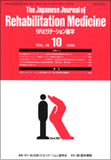Japanese
English
- 販売していません
- Abstract 文献概要
- 1ページ目 Look Inside
- 参考文献 Reference
要旨:パーキンソン病(PD)患者において歩行障害は難治性であり,その対策として在宅で実施可能な歩行訓練の開発が望まれている.本研究はPD25例(55~77歳,平均68.9±6.3(SD),Hoehn & Yahr Ⅱ~Ⅳ)を対象にしてビデオモニターを用いてモデルの運動を真似て腕振りや足踏みなどの在宅運動を3~4週間実施し,22例が訓練を終了した.訓練前後で歩行を比較すると10m往復歩行時間(前/後=29.6/24.3秒;p=0.002),1歩(step)の歩幅(前/後=43.7/50.1cm;p<0.001),歩数(cadence)(前/後=108.1/109.8歩/分:p=0.462)となり,歩行時間と歩幅が有意に改善した.しかし,脱落した3例中2例にすくみ足を有し,十分な訓練が施行できなかった.歩行速度の改善はcadence前値が少ない症例ほど高く,歩幅の改善は歩行速度が遅く,歩幅が小さい症例ほど高かった.腕振り運動はリズムキューの応用であり,ビデオを利用することにより在宅でも簡単に実施できる.
Abstract : Gait disturbance is a serious problem in Parkinson's disease (PD). Exercise therapy is used to alleviate this complaint. We investigated the effects of a videotaped arm swinging-based home exercise program on gait in PD patients. The subjects included 25 outpatients aged between 55 and 77 years (average age 68.9 years) with PD in Hoehn and Yahr stages Ⅱ-Ⅳ. We prepared a master video tape in which a trainer was shown to be performing an arm swinging exercise or steps in synchrony with a metronome. The exercise menu consisted of 4 parts : arm swinging in a seated position, arm swinging in an upright position without stepping, arm swinging with stepping, and walking on the floor or taking a walk. The patients performed the arm swinging exercise while watching a video tape everyday for a period of 3-4 weeks. Of the 25 patients, 22 completed the exercise program. Following the program, these patients showed significant improvements in their walking times for a 20 m walk (10 m, return, 10 m) (before/after=29.6/24.3 sec, p=0.002) and in the step length (before/after=43.7/50.1 cm, p<0.001). Frozen gait was a negative factor to complete the programs. Improvement of gait speed after the exercise was related with less frequency of cadence. Loss of arm swinging in PD may be associated with a disturbance in the internal rhythm formation process. Arm swinging exercises are one of the exercise methods that use rhythmic cues. This study suggests that a videotaped arm swinging-based home exercise therapy is effective in such patients.

Copyright © 2008, The Japanese Association of Rehabilitation Medicine. All rights reserved.


